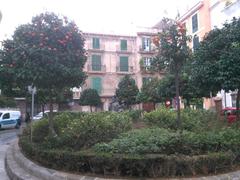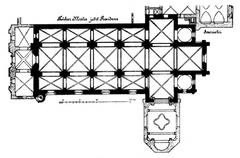
Discover the Charm of Rybnik, Silesian Voivodeship, Poland
Date: 29/07/2024
Captivating Introduction
Ever wondered where the heart of Silesia beats strongest? Welcome to Rybnik, a city where medieval fish farms have transformed into a modern cultural oasis! Rybnik, whose name literally means “fishpond,” is a hidden gem nestled in the Silesian Voivodeship of Poland. This charming city offers a rich tapestry of history, culture, and nature that beckons curious travelers. From its early beginnings as a Slavic settlement in the 9th and 10th centuries to its vibrant present, Rybnik’s evolution is nothing short of fascinating. Imagine strolling through the old town’s cobblestone streets, where the scent of freshly baked ‘kołocz’ cakes mingles with the sound of church bells. Here, history and modernity dance in perfect harmony, creating an experience that’s both enchanting and unforgettable. Whether you’re exploring the secret underground tunnels used during World War II or savoring a cup of legendary hot chocolate at ‘Silesian Nook,’ Rybnik promises a journey filled with hidden treasures and sensory delights. Ready to uncover the secrets of Rybnik? Let’s embark on an adventure through this captivating city, where every corner has a story to tell.
Table of Contents
- Historical Overview of Rybnik, Silesian Voivodeship, Poland
- Cultural Significance of Rybnik, Silesian Voivodeship, Poland
- Call to Action
Historical Overview of Rybnik, Silesian Voivodeship, Poland
Early Beginnings and Medieval Period
Rybnik’s origins can be traced back to the 9th and 10th centuries when three Slavic settlements existed on its present-day territory. These settlements eventually merged to form one town. The name “Rybnik” derives from the Proto-Slavic word for “fish” (ryba), highlighting the importance of fish farming for the city’s economy in the Middle Ages. This is reflected in its coat of arms to this day.
During the medieval eastward migration of German settlers, known as Ostsiedlung, Rybnik was incorporated under the Magdeburg Law before 1308. This incorporation granted the town city status and rights, although it continued to be part of the Kingdom of Poland until most of Silesia became a fiefdom of the Bohemian Crown in 1327. Despite this, Rybnik was still ruled by local Polish dukes of the Piast dynasty until 1336.
Development and Industrialization
Rybnik remained a small town for centuries, with its population exceeding 1,000 people only in the late 1700s. The town’s development accelerated after Upper Silesia was annexed by Prussia in 1740. In 1818, Rybnik became a county seat, and in 1856, it was connected by rail to Racibórz. Two years later, in 1858, Rybnik gained a rail connection with Katowice, further accelerating its growth.
The discovery of large coal deposits around Rybnik in the late 1800s and early 1900s brought significant capital inflow and population growth to neighboring villages and settlements. However, Rybnik continued to be primarily a market town rather than transforming into a large industrial city like other towns in the region. This changed after World War II when the Polish communist government increased coal production in existing coal mines around Rybnik and built a new city for miners nearby. By 1972, Rybnik’s population had grown to 44,400 people.
20th Century and World Wars
The late 19th and early 20th centuries saw intensifying Germanization and anti-Polish policies in the German Empire, leading to growing tensions between German nationalists and indigenous Poles. After World War I, the Polish state was restored in 1918. Amidst ethnic unrest, the Polish Silesian Uprisings broke out, with the first uprising in 1919 centered on Rybnik. The Upper Silesia plebiscite held in 1921 determined the future state affiliation, with the lowest share of pro-German votes registered in the districts of Rybnik (34.7%) and Pszczyna (25.9%). However, in the city of Rybnik, 70.8% of the votes were in favor of Germany. Despite this, the city and the larger part of the Rybnik district were attached to Poland, making Rybnik Polish-ruled for the first time since 1788.
During the interwar period, Rybnik was part of the Silesian Voivodeship and enjoyed far-reaching political and financial autonomy. In 1933, brothers Karol and Antoni Szafranek, eminent Polish musicians, founded a music school, today known as the Karol and Antoni Szafranek Secondary and Tertiary State School of Music.
World War II saw Rybnik captured by Germany, with its population either “re-Germanized” or disfranchised and partially expelled into General Government (German-occupied central Poland). The Nazis operated a prison in Rybnik, with local teachers and school principals among those killed during the occupation.
Post-War Period and Modern Era
After World War II, Rybnik became a significant industrial center under the Polish communist government, which focused on heavy industrialization. The city’s economy diversified in the 1990s, with commerce, healthcare, and business industries playing a more prominent role. Today, Rybnik is a prominent industrial center with a diverse economy that includes manufacturing, services, and commerce.
Rybnik is also recognized for its contributions to music, with the Szafrankowie School of Music producing notable musicians such as Henryk Górecki and Lidia Grychtołówna. The city is home to the Rybnik Philharmonic Orchestra, further cementing its status as a cultural hub.
Cultural and Historical Landmarks
Rybnik boasts several historical landmarks that attract tourists and visitors. The Rybnik Castle, dating back to the 14th century, is a significant historical site. The St. Anthony of Padua Church, a beautiful example of Gothic architecture, is another must-visit landmark. The city’s historical center is a treasure trove of architectural wonders, with well-preserved medieval buildings and captivating cobblestone streets.
The Rybnik Market Square is a vibrant area where visitors can admire the beautiful architecture of the surrounding buildings and sample traditional Polish cuisine at local restaurants or cafes. For nature enthusiasts, the Rybnik Reservoir offers opportunities for boating, fishing, and picnicking along its shores, with scenic walking and cycling trails surrounding the area.
Cultural Significance of Rybnik, Silesian Voivodeship, Poland
A Journey Through Time and Culture in Rybnik
Welcome to Rybnik, a city where dragons once roamed and the echoes of coal miners’ songs still reverberate through the cobblestone streets. Did you know that Rybnik’s name comes from the Polish word for ‘fishtank’? In fact, this charming city was once a hub of fishery in medieval times, and you can still sense that aquatic heritage in its serene lakes and rivers.
Imagine strolling through Rybnik’s bustling market square, your senses tingling with the scent of freshly baked ‘kołocz’ cakes, the sight of vibrant folk costumes, and the sound of street musicians playing traditional Silesian tunes. As a local friend might say, ‘Rybnik is where history and culture dance together in perfect harmony.‘
Discover Rybnik Like a Local
Hidden Gems and Local Secrets
Beyond the popular tourist spots, Rybnik is home to some truly unique treasures. Ever heard of the secret underground tunnels beneath the city? These passageways, used during World War II, are now a thrilling exploration site. And don’t miss the quaint little café ‘Silesian Nook,’ known only to locals for its legendary hot chocolate.
Sensory Delights
Feel the cool breeze as you wander through the lush Municipal Park, hear the melodic chirping of birds, and taste the hearty flavors of ‘Żurek’ soup. Engage all your senses and truly immerse yourself in the Rybnik experience.
Interactive Challenges
Why not turn your visit into a mini-quest? Challenge yourself to find all the historical plaques scattered around the city or embark on a photo scavenger hunt for the best street art murals. Each discovery will deepen your connection to Rybnik’s rich past and vibrant present.
Embracing Cultural Etiquette
When in Rybnik, remember to greet with a friendly ‘Dzień dobry!’ (Good day) and always respect the local customs. Did you know that it’s customary to bring a small gift when visiting someone’s home? These little insights will make your stay even more enjoyable.
Practical Tips with a Twist
Navigating Rybnik is a breeze, especially with our fun rhyming guide: ‘From the train station, head straight down the lane, to find the market square, it’s easy and plain!’ Use quirky rhymes to make your exploration more memorable.
Pop Culture and Local Legends
Rybnik has its share of pop culture moments too. Fans of the movie ‘The Pianist’ might recognize some of the city’s historic sites. Plus, local legends speak of a dragon that once guarded the city – a story that adds a touch of magic to your visit.
Seasonal Wonders
Rybnik transforms with the seasons. In winter, the city sparkles with festive lights and an ice rink in the market square. Spring brings blooming flowers and lively outdoor festivals. Each season offers a unique way to experience Rybnik.
Myth Busting and Surprises
Think Rybnik is just another sleepy town? Think again! With its vibrant arts scene, dynamic nightlife, and innovative tech hub, Rybnik is full of surprises waiting to be discovered.
Engaging Stories
Dive into the tales of coal miners who shaped the city, or the love story of a local couple that inspired a famous Silesian ballad. These stories bring Rybnik’s history to life in a personal and engaging way.
FAQs
Q: What is the best time to visit Rybnik? A: Each season has its charm, but spring and fall offer the mildest weather and vibrant festivals.
Q: How do I get around the city? A: Rybnik is very walkable, and bicycles are a popular choice. There’s also a reliable public transport system.
Call to Action
Rybnik is not just a city; it’s a living, breathing testament to resilience, culture, and history. From its medieval origins as a hub of fish farming to its current status as a vibrant industrial and cultural center, Rybnik has continually evolved while preserving its rich heritage. As you explore its historical landmarks, such as the Rybnik Castle and St. Anthony of Padua Church, you’ll find yourself transported through time. The city’s cultural scene, from the annual Fish Harvest Festival to performances by the Rybnik Philharmonic Orchestra, offers a delightful blend of tradition and modernity. Whether you’re navigating the city using quirky rhymes or engaging in a treasure hunt, Rybnik ensures that every moment is filled with discovery and joy. Each season brings its own charm, transforming the city into a winter wonderland or a blooming paradise in spring. Beyond the obvious tourist attractions, Rybnik’s true essence lies in its hidden gems and local secrets. So, why not let Audiala be your guide? With expertly crafted audio guides, Audiala will help you uncover Rybnik’s hidden gems and stories, making your visit truly unforgettable. Download Audiala and start your adventure in Rybnik today!














